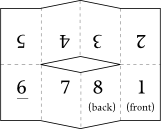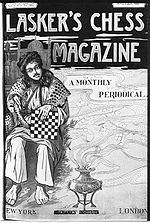Zine Making/Print version
| This is the print version of Zine making You won't see this message or any elements not part of the book's content when you print or preview this page. |
- Note: the latest version of this book can be found at http://en.wikibooks.org/wiki/Zine_making
 |
Zine Making is a featured book on Wikibooks because it contains substantial content, it is well-formatted, and the Wikibooks community has decided to feature it on the main page or in other places. Please continue to improve it and thanks for the great work so far! A {{Goodbook}} template should be created to advertise it. |
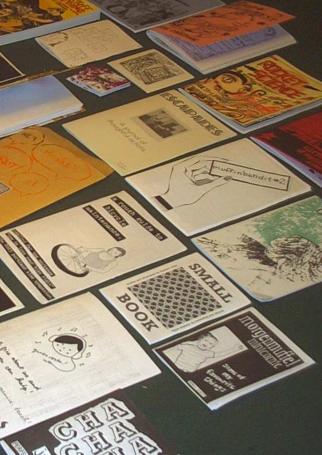
A "zine" is an independent publication, a DIY magazine-like thing. Because you do it yourself it can be pretty much anything you want it to be. This wikibook is not about the style or content of what you do with your zine, since it can contain almost anything you want (that's the joy of zines!), but instead is intended to help you with some of the practicalities of how to make a zine, about putting paper and ink (or whatever) together to make something interesting that you can put out.
This guide aims to be fairly international and not connected to any particular "scene", so there aren't any addresses or country-specific things (e.g. about the postal system, legal system...). Hopefully you'll find it useful.
Table of contents
[edit | edit source]- Writing the pages
- Putting pages together: stapling, stitching, folding, etc
- Making copies
- Selling/giving copies to people
- Other resources about zine making
- Authors
See also
[edit | edit source]
Writing the pages
[edit | edit source]To some extent the way you write your pages depends on what you're doing. If it's a zine of your hand-drawn cartoons then your best option is to hand-draw some cartoons. If it's an art zine then the appearance is going to be defined by what you're trying to achieve artistically. And so on. But here are some things to bear in mind:
General considerations
[edit | edit source]- For most copying purposes, colour is much more expensive than black-and-white (for photocopying, printing, etc). That's why most zines are in black and white. There are lots of things you can do to add a bit of colour, such as using coloured paper/card for the cover, or including one or two full-colour sheets in your zine (rather than the whole lot; it depends on your production method whether you can do this), or adding some colour after the zines have been produced.
- If you're going to use a photocopier or a computer printer to print the pages, you'll probably find they don't print all the way to the edges of the paper, so you should probably experiment a little bit and make sure you don't go all the way to the edge on your "master copy".
- Especially if photocopying, you'll probably find that subtleties of lightness and darkness won't come out very well. Stark black-and-white will photocopy most clearly.
- If you have access to a scanner, try scanning the master copy to a computer instead of photocopying. Benefits include the ability to see exactly how the printouts will look, and the ability to make adjustments, without having to use paper and ink.
Materials
[edit | edit source]Pen/pencil etc
[edit | edit source]
Hand-written / hand-drawn things can be brilliant.
- Remember the point above about being able to copy it - if you photocopy something done with pencil on paper, often it comes out really faint. Biro (disposable ballpoint pen) can come out faint too. You can fiddle with the photocopier's brightness settings to make it clearer, or if you can scan it into a computer you can make it come out much clearer and have a lot more control over it. Alternatively, just trace over the pencil lines with a dark pen. You might not like the way the lines can look doubled-up, but often the photocopier pretty much loses the pencil lines altogether and the end result looks pretty good.
Typewriters
[edit | edit source]
Typewriters are great and can make good-looking text that's not as boring as printed-out text from a computer, yet more legible than handwriting... but typewriters are becoming rarer and rarer these days so for many people they might not be available. However you can get a typewriter on eBay for pretty cheap, also check garage sales and thrift stores or even ask friends or relatives who have updated to computers.
Computers
[edit | edit source]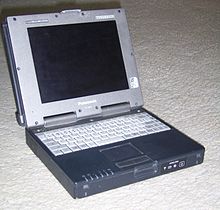
OK, so computers are capable of quite a lot, and we can't possibly cover all of it here. You can type/draw things directly using your computer, you can add photos from your camera/phone/etc, you can scan drawings/writings/etc in.
- If your zine is really quite text-based then a full word-processor like Apple Pages, LibreOffice Writer, Google Docs, Microsoft Word or AbiWord can be fine.
- If you want to make your zine look pretty and have things laid out interestingly then a word-processor gets a bit limiting and it's difficult to stop things looking a bit samey, so you might find it better to just use a graphics program. Alternatively you can write your text, then print it out and then use cut-and-paste or whatever to organise/decorate the text more interestingly.
- In most word processors you can use the columns feature to help arrange things. For example, use the page setup to set the pages as landscape, then use the "columns" options to specify that there should be two columns on each page. Hey presto, you now have a layout that can easily be typed and then folded to make the standard codex (book-like) folded zine.
- If you're going to be scanning and printing a lot, then a good graphics program is helpful. (The "paint" software that comes with your computer can be a bit frustrating!) Commercial programs like Photoshop and Paintshop Pro are well-known and they're very good. If you can't afford those, or even if you can, you should definitely check out the free and open-source equivalent, which is a piece of software called GIMP (GNU Image Manipulation Program). Despite the unusual name, it's a full-featured and very good piece of software, and you're very likely to be able to do everything you want to do with it. Inkscape is also good, especially for vector graphics.
- For desktop publishing software Scribus is free too.
- LaTeX, a piece of free/libre software used for professional type setting, particularly in the maths and sciences, is another possibility.
Cut and paste
[edit | edit source]A lot of zine-making involves cutting and pasting, to compile your images and/or words. People also use it to incorporate things from other sources.
We're not going to consider anything about the legal/moral/political dimensions of making cut-and-paste works out of other people's stuff here. It can look brilliant; but at the same time if you're just taking someone else's work and dropping it into your own zine then you haven't really done anything.
Practically, remember the thing about contrast if you're going to be making copies. Also remember that if you're cutting-and-pasting from glossy paper (such as magazines) then it can sometimes photocopy really badly because the gloss on the paper just shines when it gets in the photocopier, and you end up with a bright white thing instead of your desired image (at least partially).
If you've cut and pasted your stuff all together then it can be very helpful to photocopy it to get a kind of "master copy" that doesn't have bits everywhere.
Photos
[edit | edit source]Photos rarely photocopy nicely. Choose ones with lots of contrasts, not too much detail (e.g. a face rather than a crowd of people) and that aren't too dark. If you can, you can probably improve results by scanning a photo, adjusting it (fiddle with the brightness, increase the contrast), and printing it back out again.
Sewing
[edit | edit source]I've seen some really good zines that make use of sewing, cross-stitch, and crafty things like that. If you're going to be photocopying or something like that, then you can still do crafty things like this, as they can often come out quite well when copied (you'll need to have good colour contrasts though). If you're going to hand-make the crafty bits on each copy then of course you have more freedom and can make perhaps more exciting items, but of course you need dedication...
Putting pages together: stapling, stitching, folding, etc
[edit | edit source]Page Layout on software
[edit | edit source]In Microsoft Word, go to Page Layout, Page Setup, Pages, Multiple Pages and choose 'Book fold' then print (save to PDF won't combine multiple pages to one sheet or in book fold order). For distribution online but for others to download and print themselves, save (or print to PDF) from your word processor, then open in Adobe Reader then print 'booklet' settings to PDF printer.
- Scribus[1]
- LibreOffice Write, Return to Print dialog, and click the Page Layout tab page. Select Brochure.[2]
Different ways to fold a sheet of paper
[edit | edit source]These are just suggestions of course but they cover some of the main ways people fold sheets into ziney shapes. We'll start off by showing how to fold a single sheet to make multiple pages, but most people need more pages than that so they use multiple sheets of paper...
Folio (folding in half)
[edit | edit source]

This is easy to do, and if you're using a word-processor it's quite straightforward to get the software to do two columns and print out very appropriately. The page numbering in the diagram to the left is for a one-sheet zine. You'll probably want more than four sides to write on so you'll probably need to attach multiple sheets together.
Note that the order of pages is not what your word-processor or your brain is likely to expect, especially if you haven't done this before. It can get even more confusing when you put multiple pages together. The example to the right shows how to fold 4 separate sheets folio-style, to produce a 16-page zine:
Quarto (folding in quarter)
[edit | edit source]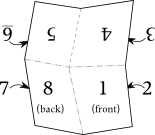
Note that some of the pages are upside-down relative to each other, so you probably can't do this very straightforwardly on a word-processor. But you like cut-and-pasting, yes?
If you want this to become a booklet-style paged thing (a "codex") you'll need to make a couple of cuts after you've attached the pages together.
Folding into six
[edit | edit source]
One nice thing about folding into six is that with standard paper sizes like A4, you get a roughly square zine at the end of it, which is quite nice.
First fold the sheet into a Z-like shape (i.e. fold it 1/3 and 2/3 of the way along, in a zigzag). Then fold it once the other way. This gives 12 approximately square sides.

Cutting the pages
[edit | edit source]If you're making a big batch of zines then you're probably going to be doing a lot of cutting, either to separate the pages or to trim things or whatever. It can get a bit tedious and slow to do it all with scissors, but if you go to a largeish stationer's you can buy a cheap guillotine which will make things easier.
Different ways to compile multiple sheets into a zine
[edit | edit source]Not attaching pages together
[edit | edit source]I've seen a lot of multi-page zines where the pages are not attached to each other, and generally that can work OK. It's certainly easier, but of course the zine is in danger of falling apart. It's up to you, of course.
Stapling
[edit | edit source]
Stapling it yourself is easy to do and nice and cheap. You might find that a normal stapler only-just-doesn't-quite-reach to the middle of your page... argh!
If you go to a largeish stationery shop you can easily find a long-arm stapler which can make life a lot easier. A library or university nearby might also have one you can use if you ask (try bringing your own staples). Or if you don't have the money you can use a normal stapler folded out flat to push the staples though the paper into a soft surface, like carpet or dense foam. Once you have done that you can then fold the staple down with something flat like a ruler or blunt knife - a sharp knife can mark or cut the pages by accident, or you!

If you're doing really big fat zines (more than about 20 pages to attach together, at a guess) then sometimes you can knacker (create technical problems) the stapler by trying to do too much. You can buy heavy-duty staplers if you want to do lots of really big fat zines.
One nice thing about some fancy photocopiers is that they can do automatic stapling, so if you have access to one of those then this can be a nice easy option. You might have to pay more for this of course.
Stitching/binding
[edit | edit source]You can make holes (often 3 or 5 holes is good) down the spine of the page and use ordinary needle and thread to bind the pages together. For example, if you make three holes, you would create a kind of tight figure-of-eight loop through the holes. This can bind things very nicely.
This is the basis of making a nicely-bound book, so it's useful to know how to do this if you want to self-publish your epic novel. There's at least one reference on DIY book-binding in the other resources section of this book.
String
[edit | edit source]You can use a hole-punch to make one, or two, holes through the pages, and then tie a loop of string through to connect the pages. Don't make the loop too tight or no-one will be able to turn the pages properly.
Single-page options
[edit | edit source]If you're printing onto a single page you can use clever folding and/or cutting to make a nice zine layout without needing to bind things.
Almost-cutting-through
[edit | edit source]If you take a piece of paper and fold it in half, then fold it in half again, you have 8 sides. You'd need to make a cut (along the line of the first fold) to make them into a booklet-like codex, but this gives you two separate pieces. One nice trick you can manage is to not make the cut all the way through - leave a small amount of un-cut paper in the middle, and this lets people turn the pages without completely separating the pieces.
No cutting, just folding
[edit | edit source]This doesn't give a booklet-like result (more of a thing to be folded out) unless you do some cutting. But it's easy to do and who knows, maybe it suits your purposes.
An 8-sided zine from 1 sheet with 1 cut
[edit | edit source]I've seen quite a few zines made using this trick. It's a really neat way of making a proper little zine out of one sheet - all 8 sides are on one side of your piece of paper, which is convenient for photocopying etc, although you can also put stuff on the reverse side for people to see when they unfold your zine. Here are the steps:
Making copies
[edit | edit source]Hand-making
[edit | edit source]Hand-making is a good option if you're making very few indeed, or if it's based on crafty stuff, or a series of one-off things. Otherwise, remember that you've got every right to combine hand-making techniques with other techniques, such as photocopying the whole zine then sewing a front cover (or whatever).
Photocopiers
[edit | edit source]
Photocopiers are a big thing in zine-making, whether it's subtle use of the photocopier at work (or so I've heard) or the photocopier in the library. Some photocopiers will even do your stapling for you, which is very kind.
Many photocopiers do not copy all the way to the edge of the page, and some have quirks about the way they photocopy different shades/colours, so it's a good idea to try a print-run out once or twice and see if you can get it looking good, before you dial in "500" and press Go. It's a good idea to get used to a specific photocopier's quirks and then stick with that one, to avoid giving yourself a new set of headaches.
Computer printers
[edit | edit source]If you have a computer and a printer at home then it can be easy to print things out yourself, especially if you're not doing many. But after a while it gets:
- Expensive. Printer ink is really quite expensive, and (especially if you have any pages with large amounts of black on them) you'll be using up printer ink faster than you can possibly imagine...
- Frustrating. This is particularly true if you're doing double-sided things but your printer doesn't do double-sided, because you need to do a lot of sitting there feeding printed sheets back into the printer in the correct order/orientation/etc, and it can go wrong quite a lot too. It can also go a bit wrong because the printed sheets might be a bit damp or crinkly, so the printer goes a bit wrong in feeding the paper back in. Then there's also the stuff about getting it all to print out so all the folds line up nicely.
Anyway. If you are using your own printer then here are some tips:
- Remember to make sure it'll fit on the page. Most printers don't print right to the edge of the paper, which means that either the edges of what you've designed will be chopped off, or it'll be printed out slightly smaller than maybe you expected. You might find you need to leave an empty border around your work so that nothing gets chopped off.
- Do a bit of experimenting then make a template. Draw some lines (or try and set appropriate borders) in your software, print them out, fiddle about and repeat until you've got it about right, and save that file. You can use this as a basis for your pages then delete/hide any guiding lines before you print the pages out. This webpage has a couple of examples of templates: http://www.footprinters.co.uk/layout.htm
- A quick rule of thumb: if your zine doesn't fit in the page, resize it (in the print preferences or whatever) to about 97%.
Getting them printed
[edit | edit source]
If you're strongly into DIY or anarchist things you might not want to use a company to print the things for you, and that's fine. But if not:
If you're getting to the point where you're making a lot of copies (more than a few dozen) then it's probably cheaper and easier to get the zines printed on your behalf, and will get you more uniform results. Of course there are various limitations with this: the printing companies are not likely to be willing to print every fourth page using tracing paper, for example. But you could easily get a printing company to make the zines and then do some "post-processing" on the zines to add your preferred cross-stitch/hole-punch/felt-tip customizations, which is quite a nice way of combining interestingness with painless production.
Printing companies typically vary a lot when it comes to pricing, so make sure you ask around for different prices. They can also vary in helpfulness, and this can be quite important. Does the company look small and friendly? A small friendly company may be more inclined to spend time talking to you and making sure they get it right. Double points if the website gives the name, photo and direct phone number of the person who gives quotes.
Check: are they happy to do small print runs? Check that "small print run" means 50 rather than 50,000.
You don't particularly need to pick a nearby printers, because delivery is often included or inexpensive.
What info to tell the print shop
[edit | edit source]- What the finished zine will look like (e.g. 12-page A6 booklet)
- How many copies you want printed
- What weight of paper you want (e.g. 80gsm is normal printer paper, 120gsm is thick paper... ask them for advice if you're not sure)
- The color and shininess of the paper (e.g. white, glossy)
- What colors of ink you need (e.g. black, black and red, or full colour)
- If you want it delivered and how soon you need it done
- How you'll provide the original copy - either electronically (PDF, Word, jpg, by CD, email, etc) or 'camera ready' (on paper)
Selling/giving copies to people
[edit | edit source]Most people who make zines aren't doing it as a profit-making enterprise, and if you are hoping to make a living from your zine then you're probably wrong. Most people who sell their zines put them at a price which kind of approximately covers the costs of making/distributing them, so that the zine-making process doesn't bankrupt them. A lot of smaller zines (e.g. ones made from a single page of A4) are given away. It's much less hassle not having to collect money etc. And a lot of zines are swapped for other zines rather than bought. It's up to you what you do, but don't expect to see some kind of profit margin on your zine; that's usually not how it works.
Record shops / book shops
[edit | edit source]
Lots of independent record shops / book shops are happy to carry zines. Some of them have stands for them and have a sale-or-return procedure in place to let you sell them. But even if they don't, you can often ask your friendly independent record/book-shop person if they wouldn't mind having them on the counter or wherever.
Sale-or-return is the typical agreement that shops do: they'll collect the money on your behalf, and you can come back in a month (or whatever) and collect your money (hopefully) or your unsold zines. Some shops have a time-limit, for example if you don't collect them within 6 months they assume you've forgotten about them and get rid of them. Some shops take a cut of the profit, and some don't.
Distros
[edit | edit source]People who like zines and who really enjoy photocopying often set themselves up to distribute other people's zines - these are often called "distro"s. There are some large and well-established distros and millions of tiny one-person distros, but typically it's just a case of if they like it, they'll be happy to carry it for you. If you find distros which have stuff you like, or your stuff fits in with them, just ask...
Remember that it's typically all done for the love of it so it's not quite the same as approaching some publishing company. You don't need to be particularly formal, just send them a zine and/or have a conversation with them.
Zine fairs
[edit | edit source]People who like zines and who really enjoy herding cats often set up a "zine fair" or "zine symposium" or some such, in their area or for their particular scene. Have a look around to see if there's anything suitable.
Carrying zines around
[edit | edit source]If you've got a nice load of zines freshly made and you want to take them to gigs, fairs, etc, you probably want to keep them looking nice, so it's a good idea to find a sturdy box to carry them around in. If you've only got a few then anything will do, but if you get to the point of having a lot to carry around then finding an old suitcase, camera-case, or some such case with a handle or strap can be really helpful.
Other resources about zine making
[edit | edit source]Online information
[edit | edit source]- http://www.zinebook.com/resource/zinetips.html
- Plenty of advice in this fairly long article
- http://zinewiki.com/
- A wiki devoted to zines and independent media. It covers the history, production, distribution and culture of the small press.
Books, zines, etc
[edit | edit source]- How to make books, a chapter by "robnoxious" in Making Stuff and Doing Things: A collection of DIY guides to doing just about everything, edited by Kyle Bravo and published by Microcosm Publishing, 2006.
- This has a lot of nice info about how to do proper good book-binding yourself, including some diagrams about folding zines, stitching pages together, etc.
- Bookbinding describes how to do book-binding yourself.
- Drafting describes tools and techniques that may be useful in zine making.
Authors
[edit | edit source]- Dan Stowell
- Incorporating (with permission) some material by P Law







